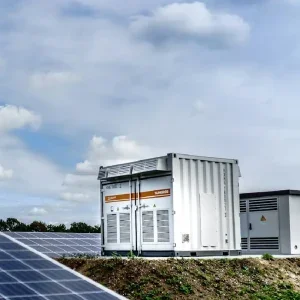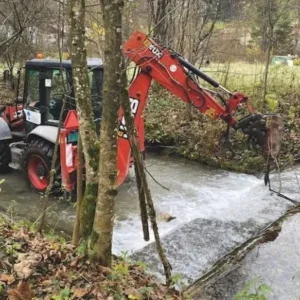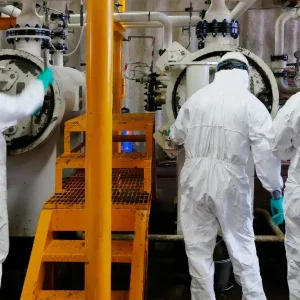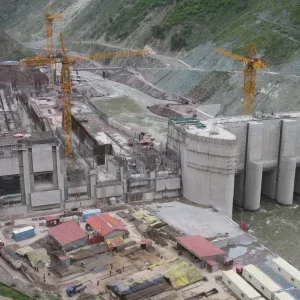
The Northwich bio-energy plant will be the first in the world to chemically process unsorted household waste, without prior treatment, using enzymes. It will be an independent merchant facility, treating commercial waste, municipal waste and fines that are supplied from existing intermediary waste transfer and treatment sites. The necessary new technology, called REnescience, has been developed by Dong Energy and has been under test at a demonstration plant in Copenhagen since 2009. In January 2014, following 10 000 hours of testing, it was made commercially available. The main advantage of such a plant, says its maker, is that a much larger proportion of household waste can be recycled and converted into biogas energy.
This is primarily because the anaerobic digestion treatment is a low-temperature, biological process. It is designed to treat the mixed, residual waste that remains after recyclable materials have already been separately collected. It complements existing recycling schemes and helps to improve the overall recycling rate by recovering materials from waste that might otherwise have been landfilled or incinerated.
Dong Energy will finance, build and operate the plant, which is scheduled to be operational in 2017. Around 150 people will be involved during the peak phase of construction, with an average of 75 at any given time. The plant will also require around 24 full-time local employees to operate it.
The plant will be able to receive unsorted household waste, which will be converted into biogas, recyclable plastics and metals. The biogas is converted to electricity via gas engines. It will have an annual capacity of 120 000 tonnes of waste, which will be supplied by the UK waste management company FCC Environment. The design and planning stages have been completed, and Dong has scheduled construction work to begin in the first quarter of 2016.
The patented REnescience technology is said to be very efficient at capturing organic materials and can help to increase recycling rates by extracting clean materials such as plastic bottles. REnescience does not involve waste incineration but uses enzymes, mechanical sorting and anaerobic digestion to produce biogas. In the case of Northwich this gas will be used to generate approximately 6.2 MW of renewable electricity, as well as clean recyclable materials and other products. 1.2 MW of the output will be used on site, and the remainder exported to the grid. Contracts for supplying the
generation sets have not yet been signed.
The process
The REnescience process is undertaken at low temperature and ambient pressure conditions in two fully enclosed vessels, the bioreactors, which are sealed rotating horizontal cylindrical tanks approximately 45 m long and 4.5 m diameter.
Unsorted MSW is wetted and warmed to 50°C, a temperature appropriate for enzymatic hydrolysis. Through enzyme action biodegradable materials are liquefied, which permits easy separation of non-degradable solids. Processing of unsorted MSW is robust, with no requirement for shredding. This makes the process simpler, and creates a high capture rate of the biomass and recycling of materials.
Liquefaction is key. Enzymes are added into the waste stream in a specially designed reactor. The biodegradable content of unsorted waste is liquefied and separated from non-degradable solids to create a pumpable bioliquid with high biomethane potential.
In the ballistic separation process, the treated waste is separated into three fractions – bioliquid, and 2-dimensional and 3-dimensional solid fractions. The 3-dimensional fraction is transported to a washing drum, where surface residues are washed off. Used wash water is recirculated. After the ballistic separator, the 2D fraction is transported to a press, where a liquid containing organic fibres and residues is separated from the 2D fraction. This liquid is then mixed into the bioliquid stream. The 2-dimensional fraction is washed to improve storage stability and retain as much biomaterial as possible. Used wash water is recirculated to the pre-treatment stage. After washing, a second pressing takes place to increase dry matter content.
When the bioliquid exits the ballistic separator, it is mixed with bioliquid from the first pressing of the 2D fraction. Further treatment depends on the intended use of the product. In this case the liquid, which contains concentrated biodegradable material in suspension, is further treated on-site using anaerobic digestion to yield biogas for the reciprocating gas engines. The remnant digestate is semi-dried to leave a compost-like output that is suitable for use on the land.
Power generation
Up to five reciprocating gas engines will be located externally (in standard containers) and will share a single stack or bundle of flues 33 m in height. An enclosed flare up to 10 m in height will also be provided as a back-up for flaring biogas temporarily if the gas engines are unavailable, to avoid any uncontrolled biogas release. A water treatment plant will process water from the digestate ‘de- watering’ stage and provide clean water to the washing stages of the mechanical sorting process. All remaining ‘dirty’ water will be recirculated into the REnescience process, with the exception of a concentrated residual output stream from the water treatment plant, which will be transported off-site by road tankers for disposal at an appropriate facility.
Renewable electricity generated by the gas engines will be exported to the national grid or by private connections to nearby industrial consumers. The grid connection will utilise capacity in the existing 132 kV substation, located nearby, via an export transformer located adjacent to the existing substation.
A small proportion of the electricity will be used on-site to power pumps, conveyors, waste separators, AD tank stirrers and other machinery in the waste treatment process. Waste heat from the gas engines will also be used to pre-heat water from the anaerobic digestion process that is mixed with incoming waste and re- circulated into the REnescience bioreactors.
End fractions
Some output streams can be upgraded to saleable products. The bioliquid can serve as the feedstock for the production of chemicals such as lactic acid and butanol. The 3-dimensional fraction, mainly containing high value plastics and metals, is suitable for further sorting and recycling and can help reduce the requirement for using crude oil in the production of plastics.
The 2-dimensional fraction, mainly containing textiles, cardboard and plastic foils, is suitable for further sorting and recycling. The foils can also be used in the production of plastics, or with the other recovered materials compressed into refuse-derived fuel (RDF) that can be used for energy generation. Recovered recyclable materials will include ferrous and non-ferrous metal and solid plastics. Plastic bottles for example can be recycled as solid recovered fuel (SRF) that can be used for energy generation. Recovered inert materials such as gravel and glass cullet/sand can be re-used as aggregates.






